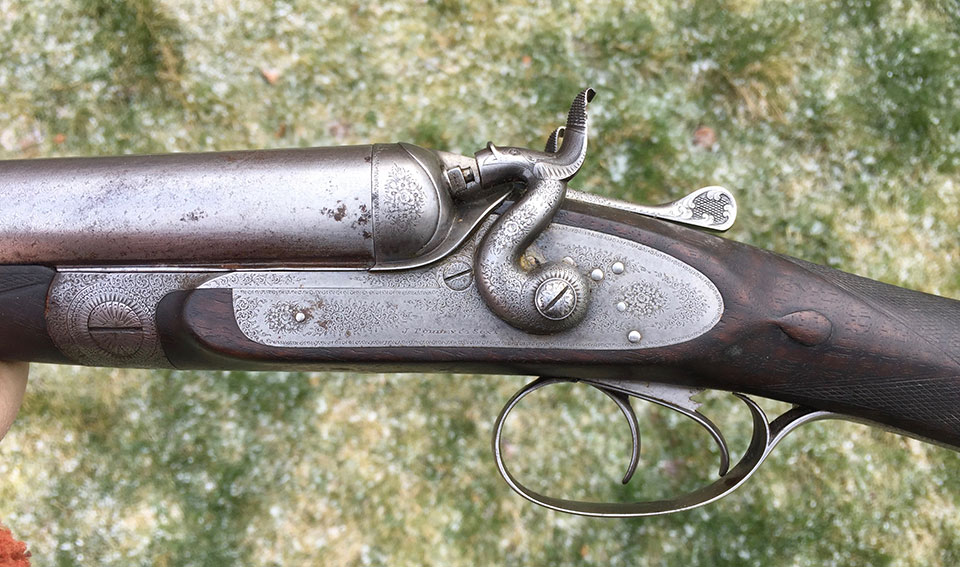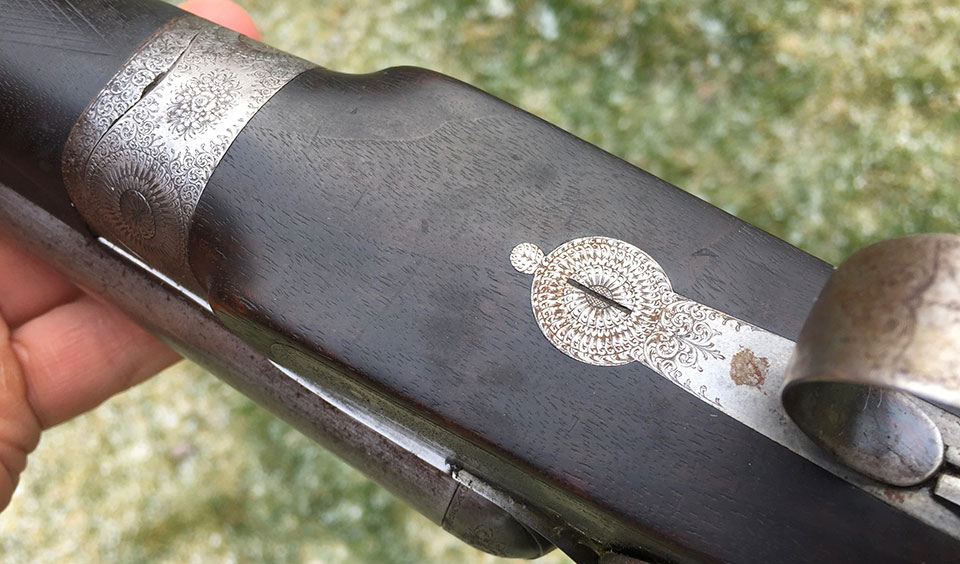The most rewarding part of my job is discovering old guns that have been stashed away for a couple of generations and emerge into the daylight unmolested, for me to see if I can restore them to their former glory.
I have written about the guns that we in the trade call ‘sleepers’ before. This time I thought it might be interesting to look at a couple of recent examples and recount their stories. Both are hammer guns by two of my favourite makers and both arrived under my gaze with potential that I hoped could be realised. Checking a gun over for the first time is always a little nerve-wracking. Was it a wasted journey? Are the barrels gone? Will it have to be sleeved? All the questions you want to only have one answer go through your head as you put the bore gauge into the barrels and run them up and down the wall thickness gauge or tap the sides to hear that reassuring ring that confirms the loop and ribs are soundly attached.

My two recent arrivals were hammer guns; one by James Purdey and the other by Stephen Grant. The Purdey is a 12-bore built in 1891, with Purdey’s concealed third bite and a beautifully fitted and shaped bar-in-wood style action. A bit of research uncovered that the original owner was Lord Rainsford, who died in 1917. With 30 inch Damascus barrels, a 14 1/2 inch stock and weighing 6lbs 8 1/2 oz, it is a classic of the period, quite late for a best hammer gun but Purdey did keep building the odd hammer gun well into the 1920s. The last one was built in the mid 1930s.
Gratifyingly, the gun had few signs of work, and none of a concerted re-finishing attempt. The screws and pins had clean slots, all facing the right direction, the wood fitted to the metal perfectly and was either just proud or flush; exactly what one would hope to find. The barrels had some fairly good dents and signs of a few having been raised in the past but wall thickness was sufficient to deal with these issues. While very little colour remained on the locks and action, the engraving was fine, sharp and lovely in the style of James Lucas, pioneer of Purdey fine rose and scroll. The wood, while dirty and with chequer worn down flat, has never been re-finished and the drop points remain pronounced. A tiger-stripe figure hinted from below the dirt and the shape and soundness were re-assuring.
The Purdey had been left to the elderly vendor many years ago by an uncle and had been in the family for sixty years or more. We struck a deal and I drove the 129 miles home in my old Land Rover, watching the snow pile up, just as the ‘Beast from the East’ moved in. Had I left it for another 12 hours, I would not have been able to make the trip for a week or more.
I knew the gun was uncommonly good. As soon as I made customers on my books aware of it, it gathered interest and offers. Within 24 hours it was sold, pending a sympathetic restoration, to a regular customer, based in California.

The Grant came here packed in a box, from a chap who had been given it by a neighbour. He initially wanted to ‘ fix it up for a couple of hundred quid’ but when we went through the necessary work, he baulked at the cost and decided to sell it as it was.
The barrels looked terrible; pits, dents, loose ribs, just about everything you don’t want to see - but they were close to thirty thou’ thick and had never been lapped, so, I hoped there might be a way around the issues. Scotty, my barrel maker took a look and a listened to my plans, shook his head as he held them to the light and said ‘What’s the point?’. However, I had faith and Scotty beavered away for a week, then called me to say ‘They actually came up all right’. Happy days. He wanted a couple of tatty Mannlicher Schoenaur rifles I had lent him, so we did a deal and no money changed hands.

Then they went off to John for browning and came back looking rather smart. The other issue was a broken mainspring. That required a bit of manoeuvring. Not many people can make a mainspring for a Grant hammer gun - not properly. A few favours were called in and somehow the gun came back with a beautifully made and fitted spring, feeling just right and matching the other one for strength. When acquaintances heard I’d got it done, in piled the requests; ‘Can you get one made for my gun …” . Not a chance!
Actually, the broken mainspring may have saved the gun. It looks like it happened a long time ago and may be why the rest of the Grant looks relatively unused. It had been stored, not especially carefully, for many years but the chequer remained un re-cut, stock wood was proud and not re-finished and the heads of the screws and pins, like the Purdey, were sharp and unmolested.
I love the Purdey, it is a perfectly weighted 12-bore and represents the pinnacle of hammer gun making, save the fact it has no ejectors. I would love to keep it but gun dealers have to sell guns, it is our tragedy as well as our privilege. No, the Purdey had to go. But the Grant is going nowhere.

It is an 1883 16-bore with a side-lever. Not the 1871 Grant & Hodges patent, but simply a side-lever with a Purdey double-bolt locking it shut. Barrels are 30 1/4 inches (the order book says 30 inches but this kind of thing is not uncommon). I have a real soft spot for Grant side-levers and I love the 16-bore’s slightly smaller frame and elegant stance.
The Grant is staying with me - at least until I find out how well or badly I shoot with it. There are still a few stages to go through before we go afield together, however. Dave, my ex-Purdey finisher, is giving her the full strip, clean, re-chequer etc. He will also fit a 1/2” leather-covered Silver’s pad to give me a good 14 3/4 inch length of pull. When the time comes to oil finishing the stock, I’ll use my home-made alkanet root oil for colour, and finishing oils from an old recipe recounted by Richard Arnold to complete the restoration. I think the old girl will come up well.
While the wood is bare, I’ll take a trip up to West London Shooting School to have the boys there give me an opinion on fit and adjustment for drop and cast. I usually work these out myself but there is no harm re-visiting these things and getting expert input from time to time. I always learn something when I do. That is the great thing about being involved in these processes; you never stop learning. Every gun teaches you something.

Published by Vintage Guns Ltd on



